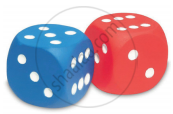Advertisements
Advertisements
प्रश्न
Two dice are rolled, find the probability that the sum is equal to 1
उत्तर
Sample space (S) = {(1, 1) (1, 2) (1, 3) (1, 4) (1, 5) (1, 6) (2, 1) (2, 2) (2, 3) (2, 4) (2, 5) (2, 6) (3, 1) (3, 2) (3, 3) (3, 4) (3, 5) (3, 6) (4, 1) (4, 2) (4, 3) (4, 4) (4, 5) (4, 6) (5, 1) (5, 2) (5, 3) (5, 4) (5, 5) (5, 6) (6, 1) (6, 2) (6, 3) (6, 4) (6, 5) (6, 6)}
n(S) = 36
Let E1 be the event of getting the sum is equal to 1
n(E1) = 0
p(E1) = `("n"("E"_1))/("n"("S"))`
= `0/36`
= 0
APPEARS IN
संबंधित प्रश्न
A dice is rolled twice. Find the probability that 5 will come up exactly one time
A number is selected from numbers 1 to 25. The probability that it is prime is
A card is drawn at random from a pack of 52 cards. The probability that the drawn card is not an ace is
If a number x is chosen from the numbers 1, 2, 3, and a number y is selected from the numbers 1, 4, 9. Then, P(xy < 9)
A coin is tossed twice. Find the probability of getting: exactly one head
A bag contains a black ball, a red ball and a green ball, all the balls are identical in shape and size. A ball is drawn from the bag without looking into it. What is the probability that the ball drawn is:
(i) a red ball
(ii) not a red ball
(iii) a white ball.
Two dice are rolled, find the probability that the sum is less than 13
The total number of events of throwing 10 coins simultaneously is ____________.
On throwing a dice once, the probability of occurence of an even number is `1/2`.
The probability of getting number 6 in a throw of a dice is `1/6`. Similarly the probability of getting a number 5 is `1/5`.
